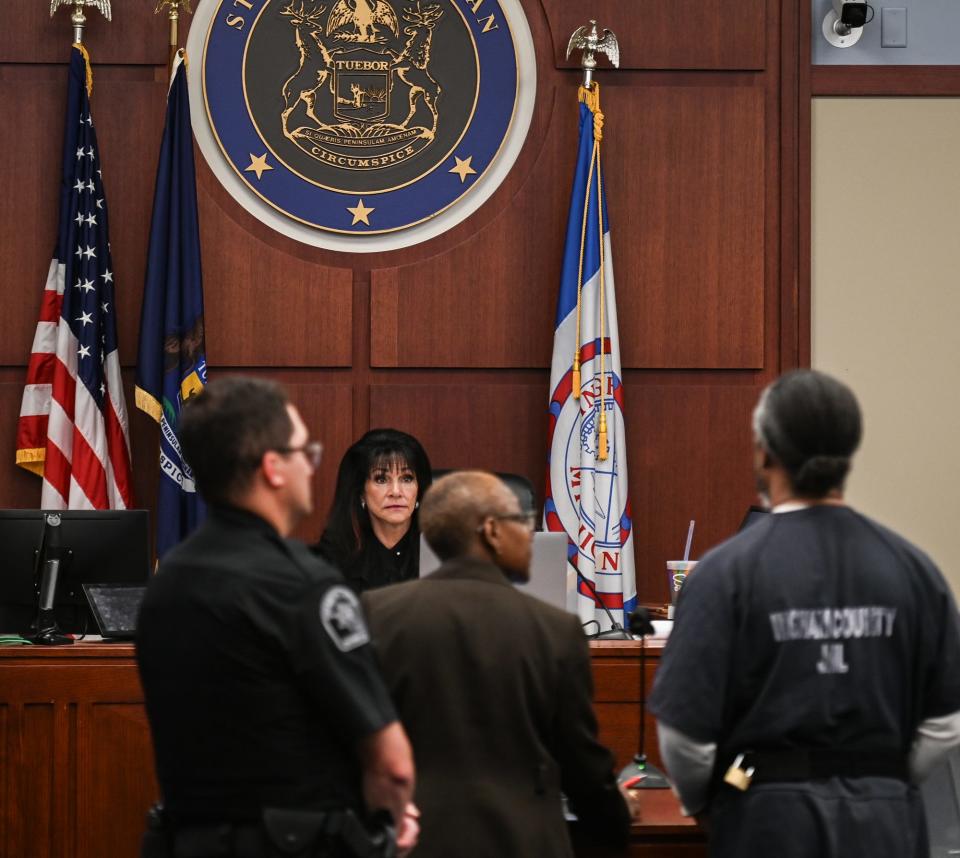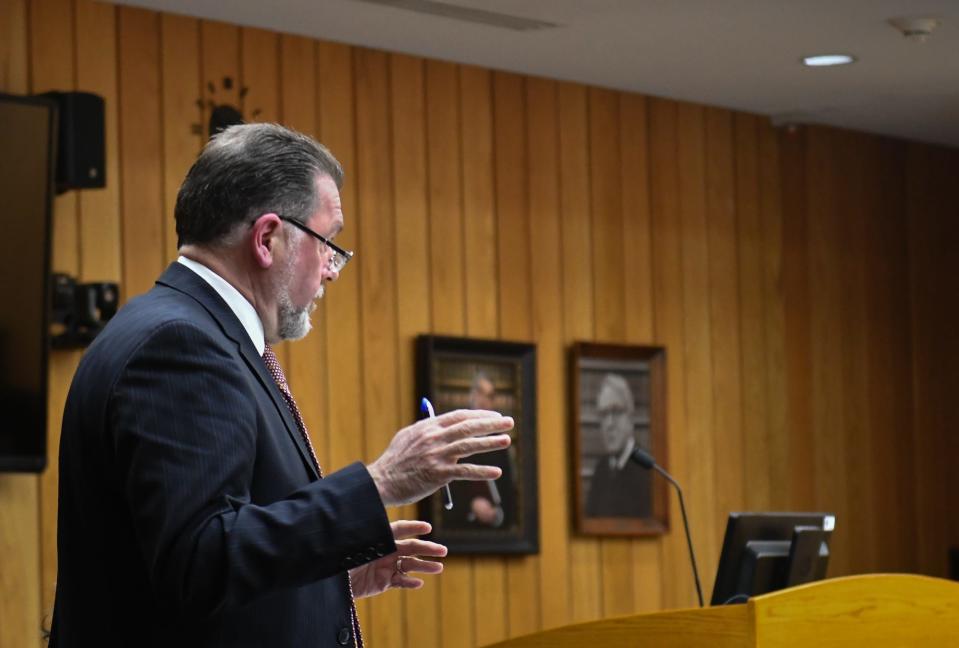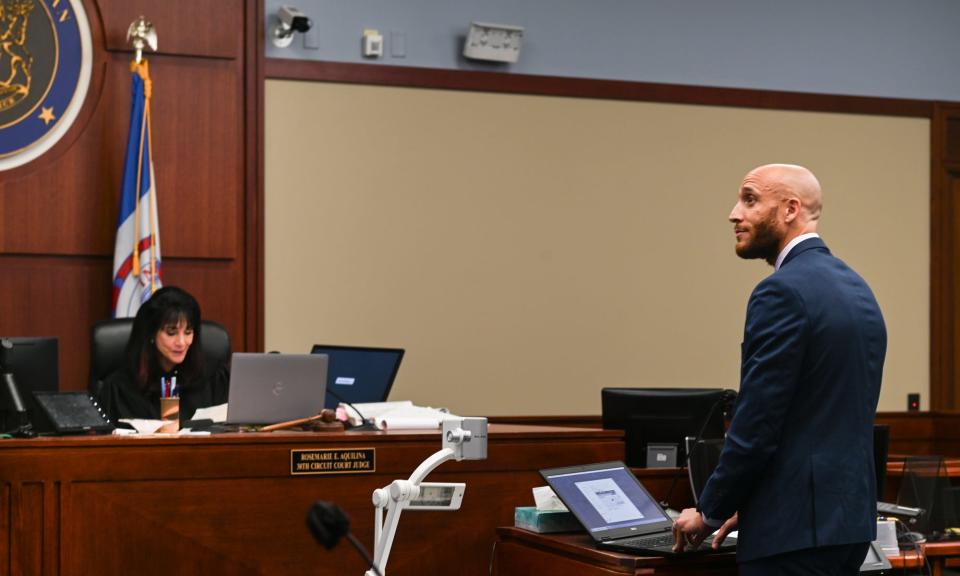Michigan's public defender system was among the worst in the country. Now it's a national model
LANSING — An important piece of state infrastructure has undergone significant work, but this isn't a construction story.
Just like its roads and highways, Michigan's public defender system had been neglected for years. Then, in 2013, lawmakers created the Michigan Indigent Defense Commission and tasked it with remaking the state's system for public defense attorneys.
In the decade since the MIDC's founding, the state's revamped indigent defense system has taken Michigan from among the worst in the country to a national model. But it didn't happen overnight. An infusion of hundreds of millions of dollars along with strict standards and a flexible system that fits counties large and small put Michigan at the forefront, experts said.
Experts have estimated about 75% of people charged with a crime can't afford an attorney.
The right to counsel is foundational to the country, said David Carroll, executive director of the Sixth Amendment Center, an organization that works with local, state and federal officials to improve their indigent defense services. The group gets its name from the constitutional amendment that established the right.
"Courts in America have been appointing counsel since before we were a country," Carroll said. "And it's in the Bill of Rights for precisely the same reason that everything else is in the Bill of Rights. It's an anti-tyranny right."
The law that created the MIDC came after a study found deficiencies in Michigan's system for indigent defendants.

In 2016, three years after the MIDC law was enacted, a State Journal investigation found that attorneys representing people in the Lansing area who faced life in prison for charges like homicide put in about three days of work to defend their client. Defense attorneys were paid little and, in some cases, reached out to prosecutors to negotiate a plea deal before meeting with their client. Trials were extremely rare.
State funding for public defenders has increased each year since 2019, but that's a result of a phased-in approach for the new standards — from having court-appointed attorneys at arraignment to continuing education — being put in over time rather than all at once.
"I've seen states that have tried to throw money at the problem without tying it to standards (which) has not been successful," Carroll said. "They basically end up buying the same system at a greater cost."
Carroll also credited Michigan for letting cities and counties pick the system they need, rather than requiring entities from Wayne County to Marquette County to use the same design.
And that was the plan, said Kristen Staley, the MIDC executive director.
Today, local governments can decide whether a public defender office — structured like a mirror image of a prosecutor's office — or a less formal system is best. Staley said they looked at states such as Ohio and Kentucky that have statewide public defender offices but felt that wasn't the right approach with Michigan's diverse populations and geography.
And they've been proven right, she said, as the yearly funding increases have coincided with higher numbers of motions and ultimately trials for indigent defendants, a sign of more aggressive representation. The American Bar Association recently released new best practices for public defenders, and Michigan's MIDC standards already in place meet those new standards.
"It literally saves people's lives," Staley said of the work's importance. "It keeps people out of prison cells and jail cells who shouldn't be there."
Public defender funding more than doubled since 2019

The success of Michigan's new system, for Staley and Carroll, isn't just measured by the funding that's more than doubled, from $124 million to $319 million, from 2019 to 2024. It's also the increased quality of defense, from giving attorneys more resources to simply getting them involved sooner.
"We mean it when we say we have minimal standards," Staley said. "We will enforce them. The act gave us a carrot and a stick."
The carrot is the state funding. The stick comes through the compliance plans, which local governments need to submit each year to get their funding.
A State Journal review of MIDC data since 2019 shows the carrot seems to be working. The state funding has increased 166% in those years, up to $280 million for the current fiscal year, which boosts what local governments contribute. The $38 million from all local funding units accounts for 12% of the $319 million public defender system.
In 2013, the year the MIDC began, counties spent nearly $74 million on indigent defense, according to data from the State Court Administrative Office.
Michigan's indigent defense spending is now the equivalent of $28.42 for every resident, higher than the $19.81 per person national average in 2022, the most-recent national survey available from the Sixth Amendment Center. Carroll said the country was then and still remains in a public defender crisis.
Despite the improvements, the entire public defender system funded through the MIDC accounts for about 0.4% of the state's $80.7 billion budget. For context, the public defender system is about one-third the size of the $900 million Michigan State Police budget, and a fraction of the $2 billion annual tab for the state Department of Corrections.
Funding still varies by county

Michigan's per capita funding in 2022, or the amount spent per resident, was $15.59. The following year it rose to $19.13 before passing that national benchmark on the way to $28.42 for 2024, according to State Journal analysis.
Resources and funding, however, are not uniform across the state.
In Ingham County, the per capita funding is $28.34, about even with the state average. But the rates drop for neighboring Eaton and Clinton counties, which are $22.13 and $23.17 per resident, respectively.
However, while their per capita rates are lower, Eaton and Clinton counties started further behind than Ingham County. They've increased their funding since 2019 by 81.6% and 129.2%, respectively, compared to Ingham County's 52.3%.
Genesee County currently has among the best-funded public defender systems in the state. For this year, the funding is equal to $52 per resident. That's a 675% increase from where it was in 2019, when it was just $6.72 per county resident.
Just two counties northwest, Midland County’s 84,000 residents have the lowest-funded system on a per-capita basis at $8.73 per person. But it had been lower. In 2019, the county funded its indigent defense system at $6.25 per person.
Timothy Havis, the Eaton County chief public defender, said the increased funding has made for better attorney recruitment. In the past, an attorney with 10 years of experience might try to avoid low paying public defender work. Now Havis said he can offer competitive pay, a support staff and an in-house investigator.
The Eaton County Prosecuting Attorney's Office has a $3.4 million budget for the current fiscal year. Havis' office is now funded at $2.4 million.
Keith Watson, the Ingham County chief public defender, and Ryan Pellerito, the indigent defense administrator in Clinton County, were not available for interviews for this story.
'An error can cost someone their freedom'

Havis and the other public defenders said that among the biggest benefits of the new system and MIDC standard is the time attorneys have to defend their clients.
The state now mandates how many cases a public defender can take on, setting the upper limit of felony cases at 150 a year or 400 non-traffic misdemeanors. A mixed caseload should apply the standards "proportionally," per the MIDC.
Even a little more time can make difference as not everything that's presented by prosecutors is as it appears, said Nathaniel Perry III, a former district court judge who runs the Genesee County public defender office. And it can take time to find witnesses or to send evidence for DNA testing.
"The time element affords the defense an opportunity to look at aspects (of a case) that they might not have been able to if they had been rushed," he said.
Defense attorney are now involved sooner in the process as well. The standards mandate everyone charged with a crime have an attorney at their first court appearance, often the arraignment.
That means the attorney and the defense team — which, thanks to increased funding now includes social workers and investigators — can build a higher level of trust with their client.
"It shows that you're not just a number in the system," Staley said of having "a defender" by your side from the start. "These are people's lives."
Before the reforms, Havis said it was common for a public defenders to decide their entire strategy based off a two-page police report, which isn't nearly enough to plan a proper defense. Add onto that the fact that police and prosecutors are also pushed to stretch resources, and courts are still backlogged from the pandemic.
![Kristin Staley. [Courtesy photo provided by LARA]](https://s.yimg.com/ny/api/res/1.2/mo5ApqaA5NGNFmieKVB_Tg--/YXBwaWQ9aGlnaGxhbmRlcjt3PTk2MDtoPTY1MA--/https://media.zenfs.com/en/lansing-state-journal/c52dee2f516bbaee79ea39ad44b6e86c)
"The busier we get across the board the more likely an error will be made," Havis said. "And an error can cost someone their freedom or a good amount of their finances."
The majority of new standards for the indigent defense system have now been implemented, said Staley. As a result, the annual finding levels should be more consistent going forward.
But the work isn't done.
Staley said she expects the next phase of Michigan's indigent defense system to include representing juveniles.
Contact reporter Matt Mencarini at 517-377-1026 or mjmencarini@lsj.com.
This article originally appeared on Lansing State Journal: Michigan's public defender system was among the worst in the country. Now it's a national model

